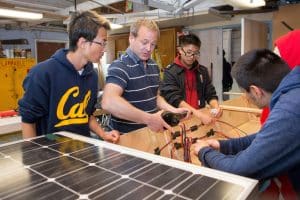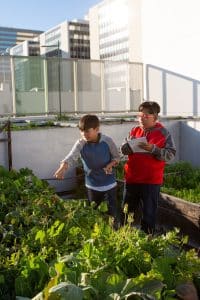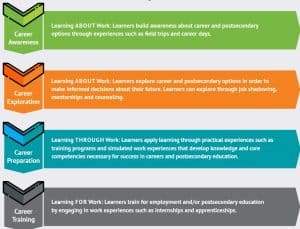The Power of Work-Based Learning in Competency-Based Education
CompetencyWorks Blog
This post is the first in a series related to the Aurora Institute’s report, Expanding Student Access to Work-Based Learning: Federal Policy Recommendations, which outlines the importance of implementing and incentivizing innovative career pathways and presents a role for the federal government to better support and guide states to carry out work-based learning programs.

The education system makes a promise to learners and the community that it will prepare young people for their futures. Ideally, an education system should empower students to reach their fullest potential by providing them with opportunities to be active participants in their learning – a goal the personalized, competency-based learning field is working toward. But for too many students the traditional, stand-and-deliver, one-size-fits-all education system continues to produce outcomes that break this promise, instead promoting short-term mastery such as for the retention of knowledge for testing. The promise of preparing students to navigate the world requires a new set of skills beyond academic knowledge, such as interpersonal skills, communication, collaboration, and problem-solving. Work-based learning (WBL) provides an effective and engaging vehicle for achieving this promise.
Competency-based education (CBE) creates a blueprint with space to incorporate other innovative approaches like WBL. WBL promotes key elements of CBE such as student agency and active learning that can happen beyond the school building. WBL brings learning beyond the classroom to life and is a powerful pathway to incorporating student-centered, competency-based learning strategies.
This blog post is the first in a series about work-based learning and its connection to competency-based learning. The series will explore these key questions: 1) How do CBE and WBL frameworks complement each other and work together? 2) What are the best practices for implementing WBL? 3) What is an example of WBL in practice?
What is Work-Based Learning?
WBL is a learning strategy that provides students with the opportunity to gain on-the-job training, develop transferable skills, and apply their knowledge to real-world situations through a partnership with an employer. WBL programs are designed as a continuum of experiences that ideally begin in the earlier stages of schooling and continue until the 12th grade. Through this continuum, students are exposed to various industries, develop professional and technical skills, and are then able to demonstrate those skills through work experience. WBL underscores the importance of diversifying learning landscapes in order for students to enhance their professional skills and build confidence in their decision-making about their career pathways. A WBL strategy helps students make meaningful connections between what they are learning and how it relates to real-world situations.
The graphic below from NAF illustrates the types of competencies students can develop through WBL. These competencies align with the goal of Element #7 in the Aurora Institute’s definition of CBE.

Integrating the WBL Continuum in K-12 Education
Learning is a marathon and not a sprint. Just like CBE, WBL functions as a continuum – with students learning a set of competencies and skills over time. As a student navigates through the continuum, they are actively building knowledge from previous lessons and are challenged with the increased complexity of each stage. By the end of the continuum, students should be able to articulate their future goals and exercise decision-making with agency. The WBL continuum of experiences can be incorporated into a student’s curriculum throughout their PK-12 academic career.
Below is AdvanceCTE’s version of the WBL continuum: career awareness, career exploration, career preparation, and career training. Each stage is meant to build off of each other. Through these different stages of WBL programs, step by step, students are developing and demonstrating skills they’ve learned in the classroom and workplace.
Career Awareness
This stage is set to begin during the early years (Pre-K – 5) of a student’s academic career and extend throughout middle and high school years. Students are exposed to various industries through workplace tours, career fairs, and field trips. In this stage, students are learning about different career options. Additionally, students can identify the required education and training steps for their desired career choice.
Career Exploration
In high-quality WBL, exploration is ideally introduced during a student’s middle school years. Students have the opportunity to job shadow in desired industries and gain mentorship from a career mentor. This stage aims to excite students to make informed decisions through exploration. In this stage, students can connect their skills and interests to different career options.
Career Preparation and Training
The last two stages of WBL typically target high school students. Students actively learn and demonstrate skills that prepare them for career experience through internships and apprenticeships. Students are learning as they work and are gaining valuable skills that are necessary for career success. In their internships, students learn how to build strong working relationships, collaborate with a team, and contribute their knowledge and skills to a larger collective.
Work-Based Learning Within Competency-Driven Pathways

Redesigning secondary education around the concept of relevant, learner-driven pathways offers promise in preparing students to engage and contribute to the current and future world with purpose and agency. High-quality student pathways like work-based learning can incorporate real-world experiences and align to a competency framework that includes a set of knowledge, skills, and dispositions that are transferable across changing contexts.
Competency-based learning is designed with an understanding that students learn at different paces and in different ways and that every student needs adequate support and resources to thrive both personally and academically. In a CBE system, students receive support to become leaders of their learning and are empowered to make decisions such as how they want to demonstrate their learning. Similarly, WBL cultivates student agency and assists students in navigating post-secondary options through career awareness, exploration, and preparation. Both WBL and CBE share similar principles for how students should learn within the education system. Aurora’s definition of CBE can be used as a framework to draw connections between the elements of WBL and CBE as illustrated with the following examples.

Anytime, Anywhere Learning
The nature of learning is rapidly changing. Advances in technology allow us to access information and learn from almost anywhere. No longer should learning only happen within the four walls of a schoolhouse. Both CBE and WBL advocate for anytime, anywhere learning and emphasize using higher-order skills. In WBL programs, students receive instruction beyond the classroom and learn skills with their employer’s guidance. The curriculum students learn directly connects to the knowledge and skills needed for their internship or apprenticeship. This allows students to find meaning in their learning and connect what they learn to real-world situations.
Strategies to Ensure Equity for All
High-quality WBL programs understand that participating in WBL can prevent some students from having other paid employment. There are students who have to work outside of school to meet financial obligations. Programs do not want to put these students at a disadvantage, so to promote equity, programs strive for students to have paid experiences. Paid experiences benefit students who need a means of earning income by connecting them to promising career paths rather than jobs with little opportunity for advancement that may also require working late hours or compete with student efforts to graduate and focus on education.
An Example in Action
The Hillside Work-Scholarship Connection is a nonprofit organization that guides students to realize their full potential and impact within their communities. A portion of the program offers participating students practical work experiences through paid employment. Each student is paired with a school-based youth advocate (YA), who serves as a mentor to students. With the help of their YA, students create an individualized plan that targets the following factors: high school graduation, job placement, career planning, college advancement, and other personal goals. Additionally, the YA assists students by regularly checking in with their family and teachers to identify any challenges the student may be facing. This WBL program provides students with special support so that students can have the tools to be agents of their own success.
WBL and CBE Are Better Together
We know that if we want to prepare young people for the new world of work and to thrive in their futures, we can’t keep operating within the confines of the traditional education system. WBL is a student-centered learning approach that expands students’ learning landscape beyond the classroom and provides opportunities for students to demonstrate their knowledge. Through WBL’s continuum of experiences, students are encouraged to take the lead on a pathway to their own academic and professional success. WBL aligns with components of CBE by actively engaging students in the learning process and diversifying how students learn to better prepare them for post-secondary learning, career, and life.
Learn More
- Best Practices for High-Quality Work-Based Learning
- The X3 Internship Program Models a Vision for Work-Based Learning
- Increasing Access to Work-Based Learning: Federal Policy Recommendations
 Khamiah Alderman joined the Aurora Institute as an intern with CompetencyWorks in January 2023. She is a recent Public Policy graduate from the University of North Carolina at Chapel Hill. She is passionate about educational equity and is working to better the education system for all learners, regardless of race, gender, religion, and ability.
Khamiah Alderman joined the Aurora Institute as an intern with CompetencyWorks in January 2023. She is a recent Public Policy graduate from the University of North Carolina at Chapel Hill. She is passionate about educational equity and is working to better the education system for all learners, regardless of race, gender, religion, and ability.
She currently serves as the Youth Program Manager for the Center for Racial Equity in Education in Charlotte, North Carolina. In this position, she is building a program dedicated to developing leaders who are informed and empowered to act locally at their schools and at the district level. In the past, Khamiah served as a research assistant for professors at UNC-Chapel Hill where she gained valuable research experience grounded in education equity, intersectionality, and African American history. She hopes to continue her work to transform the education system to be accessible for all.
